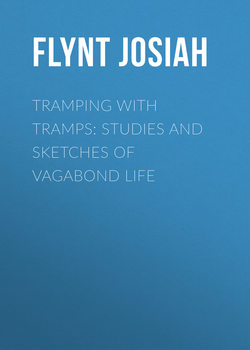Читать книгу Tramping with Tramps: Studies and Sketches of Vagabond Life - Flynt Josiah - Страница 3
PART I
STUDIES
I
THE CRIMINAL IN THE OPEN
ОглавлениеUp to the present time the criminal has been studied exclusively behind prison-bars, after he has been caught, tried, and convicted. Out of durance he is his own master, and is naturally averse to being measured and experimented upon by scientists; hence the criminologist has been forced to await the almost certain vicissitudes which bring him once more inside a prison-cell. Here he has been subjected to the most minute examinations; and there exists a bulky literature on the results which these examinations have brought to light. We have volumes, for instance, about the criminal's body, skull, and face, his whimsical and obscene writings on prison-walls, the effect of various kinds of diet on his deportment, the workings of delicate instruments, placed on his wrists, to test the beat of his pulse under various conditions, the stories he has been persuaded to tell about his life, his maunderings when under the influence of hypnotism, and numerous things, anthropological and psychological, which have been noted down, compared, and classified.
Out of this mass of information, gathered in great part by prison doctors and other prison officials, the conclusion has been drawn that the criminal is a more or less degenerate human being. There are differences of opinion in regard to the degree of his degeneracy; but all investigators agree upon the main fact, while some go so far as to claim that he is abnormally deficient in mental and moral aptitudes, and, in a large number of instances, should be in an insane asylum rather than in a penitentiary. Human justice recoils from a severe treatment of the man who, though an outbreaking sinner, bears evidence of being sinned against as well as sinning; and yet, before we can safely fall in with this view, we must carefully consider the theory on which it is based, and its claims to a scientific foundation.
The first question with which to begin a scientific investigation of this sort is, it seems to me, this: "Where may we hope to find the criminal in his most natural state of body and mind – in confinement, a balked and disappointed man, or in the open, faring forth on his plundering errands, seeking whom and what he may devour?" That he should be studied when undergoing punishment goes without saying; but I claim that imprisonment should be considered rather as an incident in his existence than its normal sphere, and that, because it has not been so regarded, we have to-day a distorted view of the criminal and an illogical tendency in penology.
It is now more than a decade since I became acquainted with tramps. My purpose in seeking them out was to learn about their life; and I soon saw that, to know it well, I must become joined to it and be part and parcel of its various manifestations. At different times during this period, – some of them lengthening out into months, – I have lived intimately with the vagabonds of both England and the United States. In the tramp class, or so near it that the separation is almost imperceptible, are to be found any number of criminals associating freely, either for purposes of business or sociability, with their less ambitious brethren. In nearly every large city of the two countries mentioned I know something about them, and in not a few instances I have succeeded in becoming well acquainted with notorious members of their class. My desire is to tell of the impression they make on one who studies them in their own habitat, that I may be able to show how different is the outdoor criminal from his convicted brother shut in behind prison-bars.
